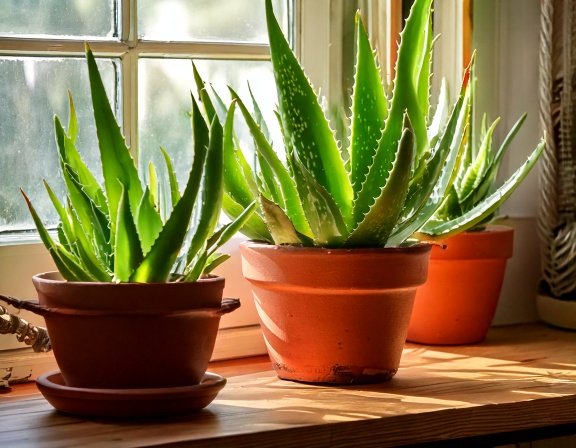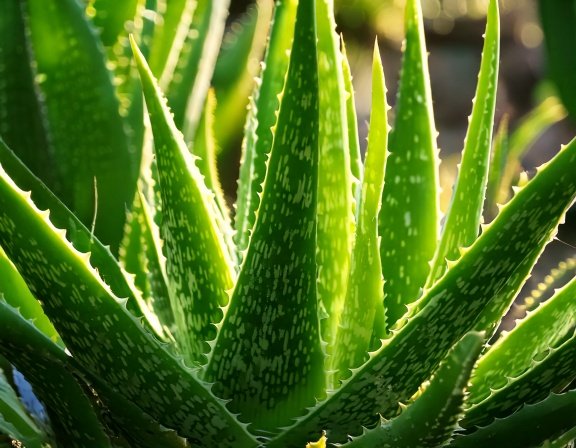Aloe Vera for Digestion: How to Grow, Harvest & Use for Natural Relief at Home
A beginner-friendly guide to growing, harvesting, and safely using aloe gel to soothe the gut and support comfortable digestion.

Digestive Calm Tea Matrix
Mix-and-match peppermint, licorice, ginger, aloe and turmeric combos to ease bloat and support a calmer gut.
Get the matrixAloe Vera is famed worldwide as a versatile healer, especially cherished for its digestive health benefits. From relieving occasional constipation to soothing irritation, Aloe Vera is an easy-to-grow medicinal plant you can cultivate right in your home. This guide will show you how to plant, care for, harvest, and safely use Aloe Vera to naturally boost your digestion.
Why aloe for digestion (and safety)
Acemannan, a polysaccharide in the clear gel, is renowned for soothing the digestive tract. However, avoid the yellow latex beneath the leaf rind—it contains anthraquinones (like aloin) with strong laxative effects. For safety context, see NCCIH and NIEHS, and general supplement guidance from Mayo Clinic.
Aloe vera’s gentle support for digestive health comes mainly from its inner gel, which contains a powerful compound called acemannan—a polysaccharide known for its soothing, anti-inflammatory, and gut-healing properties. Acemannan helps coat and calm the digestive tract, promoting balance in the stomach and intestines while supporting healthy microbial activity. Many people find that small, regular amounts of aloe gel or juice can help relieve mild heartburn, indigestion, and irritation from an overly acidic diet.
However, safety lies in using the right part of the plant. The clear inner gel is beneficial and generally safe when consumed in moderation, while the yellow latex layer found just beneath the leaf rind should be strictly avoided. This latex contains anthraquinones such as aloin, which have strong laxative effects and can cause abdominal cramping, dehydration, and electrolyte imbalances if consumed. Commercial aloe products intended for internal use are carefully processed to remove these compounds—but homemade preparations should be handled with extra caution.
For reliable safety information, it’s best to refer to trusted health organizations like the National Center for Complementary and Integrative Health (NCCIH), the National Institute of Environmental Health Sciences (NIEHS), and general supplement safety guidance from the Mayo Clinic. These sources emphasize choosing high-quality, purified aloe products labeled for internal use and avoiding prolonged or high-dose consumption.
Safety Reminder: When in doubt, consult your healthcare provider before adding aloe to your daily digestive routine—especially if you’re pregnant, breastfeeding, or managing chronic digestive or kidney conditions. With mindful use, aloe vera can be a safe and effective way to promote comfort, hydration, and balance in the digestive system.
NCCIH: Aloe vera NIEHS: Aloe latex Mayo Clinic: Aloe safetyDid You Know?
Ancient Egyptians called Aloe Vera the “Plant of Immortality,” prized for soothing uses—today we emphasize careful prep for gut comfort.
How to Grow Aloe Vera at Home


Easy-care tips
Aloe vera is one of the easiest plants to care for—perfect for beginners and busy plant lovers alike. Its hardy nature means it thrives with minimal attention as long as you meet a few simple needs: bright light, well-draining soil, and infrequent watering. Think of aloe as a desert dweller—it prefers a little neglect to too much care. Avoid overwatering, keep it in a warm spot, and let the soil dry completely between drinks. Trim away any damaged or wilted leaves to encourage fresh growth.
For best results, repot your aloe every couple of years to refresh the soil and give the roots more room. During spring and summer, you can feed it lightly with a diluted succulent fertilizer once every month or two. In winter, water even less and keep it away from cold drafts or heaters. With these easy-care habits, your aloe will stay lush, healthy, and ready to provide soothing gel whenever you need it.
- Light: Bright, indirect; morning sun is fine. Avoid harsh afternoon rays.
- Soil: Well-drained, sandy/cactus mix.
- Water: Infrequent—about every 2–3 weeks; let soil dry fully between waterings.
- Potting: Containers with drainage; repot pups as they form.
VivoGut: 14 Nutrients & Herbs for Digestive Balance
- Features a unique blend of herbs, minerals, probiotics, and natural nutrients
- No harsh chemicals or synthetic fillers
- Works with your body’s natural rhythms for gentle support
Harvesting and Preparing the Gel
Harvest Aloe leaves by choosing outer, mature leaves first. Use a clean, sharp knife to slice leaves close to the base. Allow the yellowish latex to drain before extracting clear, soothing gel. Always avoid the yellow latex—this layer can cause digestive discomfort. Rinse leaves thoroughly after cutting to remove it.


3-Day Gentle Detox Plan
Meals, teas, and a simple grocery list to reset bloat—pairs well with soothing aloe sips.
Get the 3-day planUsing Aloe Safely for Digestive Health
Aloe vera can be a gentle aid for digestive health when used carefully and in the right form. The inner gel of the aloe leaf contains enzymes, vitamins, and anti-inflammatory compounds that can help soothe the stomach lining, support regularity, and promote gut balance. However, it’s important to distinguish between the clear inner gel and the yellow latex (aloin) just beneath the leaf’s surface—the latter acts as a strong laxative and should be avoided for internal use.
For safe digestion support, use only food-grade aloe vera gel or juice specifically labeled for internal consumption. Start with small amounts—1–2 tablespoons mixed with water or juice—and observe how your body responds. Consistent, moderate use can help ease occasional heartburn, bloating, or mild constipation. Avoid long-term or excessive intake, as overuse may disrupt electrolyte balance or irritate the intestines. Pregnant women, nursing mothers, and individuals with digestive disorders should consult a healthcare provider before using aloe internally.
Quick Tip: Pair aloe juice with soothing herbs like chamomile or ginger for enhanced digestive comfort, and always drink plenty of water to support the body’s natural cleansing and hydration processes.
Fresh Aloe Vera gel can support digestion, soothe stomach discomfort, and relieve occasional constipation. Blend a tablespoon of pure Aloe Vera gel into smoothies or juices to gently benefit your digestive system.
Finessa: Plant-Based Gut & Liver Support
- Features Taraxacum, Silymarin (Milk Thistle), Cascara, Cynara (Artichoke), Turmeric, Licorice, Probiotics
- High in polyphenols and active plant compounds
- Crafted for gentle cleansing and total digestive harmony
Mayo: Aloe safety NCCIH: Aloe facts
This herbal recipe is shared for educational purposes only, based on traditional use and available sources. It is not medical advice. Please consult your healthcare provider before use, especially if pregnant, nursing, or on medication.
BioFit Review: Can a Probiotic Help Gut Balance?
Alongside soothing aloe drinks and digestive teas, targeted probiotics may support gut regularity and comfort. See our BioFit notes.
Read the BioFit reviewDisclosure: We may earn a commission if you purchase through our links—at no extra cost to you. We only recommend options we would share with family.
Want more natural wellness solutions?
Get plant-based remedies, digestive tips, and practical gardening advice delivered right to your inbox.
Subscribe now